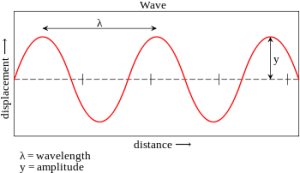Wavelength
The wavelength of a sinusoidal wave is the spatial period of the wave—the distance over which the wave’s shape repeats. It is usually determined by considering the distance between consecutive corresponding points of the same phase.

The above figure shows the wavelength at a certain time period(the figure is freezed)
In linear media, any wave pattern can be described in terms of the independent propagation of sinusoidal components. The wavelength λ of a sinusoidal waveform traveling at constant speed v is given by
λ = v/f
where v is called the phase speed (magnitude of the phase velocity) of the wave and f is the wave’s frequency. In a dispersive medium, the phase speed itself depends upon the frequency of the wave, making the relationship between wavelength and frequency nonlinear.
In the case of electromagnetic radiation such as light in free space, the phase speed is the speed of light, about . Thus the wavelength of a 100 MHz electromagnetic (radio) wave is about: divided by 108 Hz = 3 meter.
For sound waves in air, the speed of sound is 343 m/s (at room temperature and atmospheric pressure). The wavelengths of sound frequencies audible to the human ear (20 Hz–20 kHz) are thus between approximately 17 m and 17 mm, respectively. Note that the wavelengths in audible sound are much longer than those in visible light.
Difference between Wavelength and Time Period :
There are two variables. One is time and other distance.
We can draw a curve with respect to time and say the vertical displacement at a particular point which shows the period and amplitude. It is time variant at particular point.
We can also draw a curve with respect to distance at a particular time which shows the wavelength and amplitude.
More animations about wavelength are given :
http://www.animations.physics.unsw.edu.au/jw/travelling_sine_wave.htm

